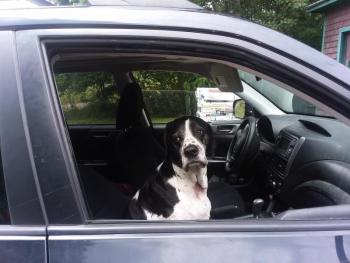Dogs, pets can quickly die in cars under summer heat; temperatures rise rapidly
Every year, countless dogs across the country are seriously injured or die from being left in hot cars, and many people, including well-meaning owners, underestimate the danger of leaving their pets in the car while they run an errand or two.
As summer temperatures soar, it can be easy to misjudge how quickly an errand run can turn tragic. It is horrific for the animals that suffer, who essentially bake in the car until their body temperature is so high that their brain and other organs are damaged, or they die.
While humans are able to cool themselves by relying on an extensive system of sweat glands, many other animals have difficulty cooling themselves, which makes them “extremely vulnerable to risk,” according to the Animal Defense League.
Older dogs and dogs with short snouts, thick hair, or obesity are predisposed to overheating, according to Pet MD.
It can take as little as 15 minutes for your dog to suffer brain damage, damage to organs, or death.
Some owners think that lowering the windows is enough to negate the rise in temperature, but studies have shown that the effect of opening windows is minimal, according to the American Academy of Pediatrics. One study showed that at the end of a 90-minute period between a fully enclosed car and one with the windows rolled down were only different by two degrees.
Even if the temperature outside doesn’t feel too hot, once a car is sealed the temperature rises rapidly.
With a temperature of 70 degrees, it takes just 20 minutes in a closed car for the temperature to reach 99 degrees, according to the American Veterinary Medical Foundation.
According to the Humane Society, even with an outdoor temperature of 72 degrees, the temperature inside a car can reach up to 116 degrees within an hour. With the temperature raised to 80 degrees outside it takes just 10 minutes for the temperature inside a car to reach 99 degrees.
The Humane Society and other animal welfare groups advise simply leaving your dog at home, in a cool place with plenty of water, when the temperatures rise, where they can remain cool, comfortable, and most importantly, safe.
Even with the windows rolled down, on 85-degree day temperatures inside a car can reach 102 degrees within 10 minutes. Dogs can suffer irreversible organ damage or die when left unattended in a car.
Some people think that leaving the air conditioning running is a sure way to ensure their pets stay safe in the heat, but even that isn’t always enough. Others say they were only going to be gone for a few minutes, but unforeseen circumstances can significantly delay return.
The Humane Society recommends never leaving your dog alone in a parked car, noting that leaving the air conditioner on isn’t enough to keep them safe.
Take action
For those who stumble upon animals left alone in vehicles in warm weather, there is action to take:
Frequently, this occurs at businesses where you can take down the make, model, and license plate number of the vehicle and have the owner paged over the business’s intercom.
If that doesn’t work, call the non-emergency line of the local police department whose offices will respond to the scene and wait for police to arrive at the car.
In Maine law enforcement officers, humane agents, animal control officers, and firefighters are authorized to “take all steps that are reasonably necessary to remove an animal from a motor vehicle if the animal’s safety, health, or well-being appears to be in immediate danger from heat, cold, or lack of adequate ventilation and the conditions could reasonably be expected to cause suffering or death.”
In these cases, written notice is left with the vehicle letting the owner(s) know where the animal has been taken.
Owners are able to claim the animal only after paying for “all charges that have accrued for the maintenance, care, medical treatment, and impoundment of the animal.”
An authorized person who removes an animal from a vehicle is immune from criminal or civil liability that might otherwise result from the removal, according to the State of Maine.
Camden Police Officer Mark Bennett, who is also the town’s animal control officer, said that when they receive a call from a concerned citizen they make a series of assessments.
“We’ll go and check and see where the dog is located, the outside temperature, how the dog is acting... I mean, if the dog is running around inside, bouncing around, then we know the dog is fine,” he said.
Other things Camden Police evaluate include the kind of dog, whether it’s a long-haired dog, and how long they’ve been left in the car.
“We also feel if the engine is hot, then we know that the dog was recently [left] in there because if the engine is still hot you know somebody just got out,” he said. “So we look at all those factors. If a dog is in distress then we have, in the past, taken the dog and brought it to PAWS [local animal shelter]. In some cases we’ll wait for the owner to get there.”
Bennett said that if the situation is bad enough police can issue a summons to owners. At least one owner has previously been cited for cruelty to animals after leaving their dog in a car for a prolonged period.
Bennett said that if the person is local they can typically find their name, address, and phone number using the vehicle’s license plate. They will then call to have the owner come to remove the dog from the vehicle.
Roughly 60 percent of the reports Camden Police receive are calls where the owner of the animal is either standing near the car or still inside of it. Bennett said some concerned citizens panic at the sight of a dog in a hot car and don’t examine it closely.
Just the other day he said he responded to a dog left in a vehicle only to find the owner sitting in the front seat reading a newspaper.
Despite this, Bennett said the police would “rather have people call and have them report it and have us check on it than to have people do it themselves or have them second guess themselves. It’s better to call either dispatch or the front office and we’ll go check,” he said.
Some patrolmen carry thermometers capable of telling them the temperature inside a vehicle.
Belfast Police patrolman Eric Kelley also carries a thermometer, according to Sergeant John Gibbs.
Bennett said it’s not advisable for people to stick their hands into a vehicle to gauge the temperature themselves due to the risk of being bitten by a potentially territorial or frightened animal.
“We do get people that will try to pet the dog to see how hot the dog is, and if the dog is hot and irritated, sticking your hand in the window is not helping anybody,” he said.
According to Bennett, the rate of calls Camden Police receives for dogs left in cars greatly varies.
“We go through phases where we won’t get one, then all of a sudden we’ll get four in one day,” he said. “I had two the other day, I had one yesterday, I haven’t had any today. It also depends on what we have for the flow-through traffic, what the weather is like and what events we have going on in town. If we have an event like the Windjammer Festival, we’ll have a lot of complaints because there [are] so many people in town and they all bring their dogs.”
Belfast Police will also respond to every complaint, though Gibbs said it is “an extreme rarity that a dog is in distress.”
Signs of heat stress in dogs include heavy panting, glazed eyes, a rapid pulse, unsteadiness, a staggering gait, vomiting, or a deep red or purple tongue.
Helping the animal
There are several steps you can take to help an overheated animal, though they should be seen by a veterinarian immediately. One step is to lower the dog’s body temperature by sprinkling cool water onto them, though soaking them is not advisable as it can drop their temperature too low.
Wet towels can also be placed in the dog’s armpits, groin, and back of the neck.
The ear flaps and paws can also be wet down with cool water.
Placing a fan on the wet areas will help evaporation and cooling.
While offering an alert dog water is fine, they should not be forced to drink, according to the Humane Society.
Although dogs do have a small number of sweat glands, primarily on their paw pads, they are covered in fur and can only provide minimal cooling. Panting is the most efficient way dogs have of cooling themselves.
According to doghealth.com, panting works by allowing “heat from the hottest part of the body, the inner thorax, to escape through moisture produced by the mucous membranes of the tongue, mouth, and throat. The dog exhales moist air, and the process of evaporation cools the dog.
While overheating in a car is one serious danger dogs face in the summer, it is not the only one.
Dogs can also easily burn their paw pads on hot pavement with no way to tell their owners. One recommended way to test whether the pavement is too hot for your dog's paws is to put the back of your hand on the surface for seven seconds, if you struggle to hold it there the whole time, it’s too hot to walk the dog on.
If you see an animal in a car you’re concerned about, you can reach area police at the following non-emergency lines:
Belfast Police: 207-338-2420
Camden Police: 207-236-7953
Rockland Police: 207-594-0316
Erica Thoms can be reached at news@penbaypilot.com
Event Date
Address
United States
























